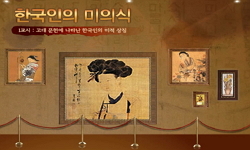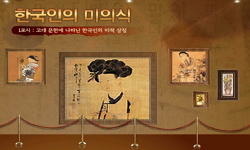What is the difference between the aesthetic beauty of the East and that of the West? How is the aesthetic beauty of Korea different from that of China and Japan? Up to the present, these have been central questions for those pursuing studies in Kore...
http://chineseinput.net/에서 pinyin(병음)방식으로 중국어를 변환할 수 있습니다.
변환된 중국어를 복사하여 사용하시면 됩니다.
- 中文 을 입력하시려면 zhongwen을 입력하시고 space를누르시면됩니다.
- 北京 을 입력하시려면 beijing을 입력하시고 space를 누르시면 됩니다.

한국 전통미 특질에 대한 제설(諸說)의 유가,도가 미학적 고찰 = A study on the Korean aesthetic beauty reflected on the Confucianism and Taoism
한글로보기https://www.riss.kr/link?id=A101863087
- 저자
- 발행기관
- 학술지명
- 권호사항
-
발행연도
2012
-
작성언어
-
-
주제어
한국전통미 ; 한국 미 ; 자연미 ; 유가도가적 고찰 ; 노경의 미학 ; 고유섭 ; Korean aesthetic beauty ; Ko Yu-seup ; naturalism ; nature ; the lack of the artificial consciousness ; taoism
-
KDC
151
-
등재정보
KCI등재후보
-
자료형태
학술저널
- 발행기관 URL
-
수록면
299-330(32쪽)
- 제공처
-
0
상세조회 -
0
다운로드
부가정보
다국어 초록 (Multilingual Abstract)
What is the difference between the aesthetic beauty of the East and that of the West? How is the aesthetic beauty of Korea different from that of China and Japan? Up to the present, these have been central questions for those pursuing studies in Korean aesthetic beauty. While there have been only rare studies on Korean aesthetics, a useful place to begin for understanding how Korean art developed an aesthetic is in Korean philosophy, and related articles on Korean Buddhism, Korean Confucianism and Korean Taoism. Buddhism, Confucianism, Taoism, and other religious elements influence the unique nature of the Korean character together with shamanism. They play a decisive role in determining the Korean mentality or consciousness. For Koreans, nature is a mirror of the self and a world of meditation which gives life, restoring all things to their proper state. Korean art also tends to be devoid of an artificial movement and this reflects dislike of disturbance, deformation and convention. Naturalism is an attribute of Korean art because of Koreans` indigenous view of nature, I. e. the view of holding communion with nature. A distinguishing characteristic of Korean art is not naturalist in the western sense of the term. The western meaning of naturalism is the science oriented term. And, if the tradition of Korean art is set against the background of a "return to nature". Especially Ko Yu-seup, the renowned art historian, once said Korean art was characterized by its "lack of refinement" and "nonchalance". He concluded that its lack of meticulous detail enabled it to be embraced by a wholeness larger than art and hence emanate a warm, comforting ambience. Ko`s view is a simple but eloquent description of the characteristics of traditional Korean art. Korean art as a whole is characterized by vitality, spontaneity and unconcern for technical perfection. Korean art has been characterized by submission to the nature, and the lack of the artificial consciousness. Thus it has developed within the framework of naturalism. Naturalism as such is a vague term. To make it more precise, we must consider the Korean"s basic philosophy lies not in a man-oriented idealism but in a naturalism oriented by nature. It is evident that such peaceful and beautiful natural surroundings nurtured love of nature in the minds of Koreans.
국문 초록 (Abstract)
한국전통미의 특질 및 고유성에 관한 논의는 다양한 시도가 있었다. 기존의 디트리히 젝켈(Dietrich Seckel), 안드레 에카르트(Andre Eckardt), 야 나기 무네요 시(柳宗悅) 등 외국인이 본 한국전통미 ...
한국전통미의 특질 및 고유성에 관한 논의는 다양한 시도가 있었다. 기존의 디트리히 젝켈(Dietrich Seckel), 안드레 에카르트(Andre Eckardt), 야 나기 무네요 시(柳宗悅) 등 외국인이 본 한국전통미 특질과 고유섭, 김원용, 윤희순, 조요한, 최순우 등 한국인이 본 한국전통미 특질이 있는데, 보는 관점에 따라 한국전통미의 특질은 달리 이해되었다. 한국전통미 특질을 분석하는 방법론으로는 디트리히 젝켈의 "대립적 변이들"에 주목하는 사유와 텐느(Hippolyte A. Taine)가 말한 지리적 결정론, 한국인의 자연관과 문화유전자를 통해 보는 등 다양한 방법론이 적용되었다. 서양과 달리 동양에서는 기교의 능숙함과 관련된 神品보다는 작가의 정신성을 우선시하고 기교와 법도 및 形似에 얽매이지 않는 無爲自然性의 逸品 혹은 逸格을 더 우선시 하는 사유를 보인다. 따라서 이런 점에 대한 심도 있는 이해가 있을 때 동양미술 혹은 한국 전통미술에 담긴 미의식을 제대로 이해하고 평가할 수 있다. 즉 서양의 눈으로 보느냐 아니면 동양의 눈으로 보느냐, 그리고 동양의 눈으로 보더라도 동양미학의 근본지향점을 알고 보느냐 그렇지 않느냐에 따라 동일한 유물이라도 판단 기준이 달라질 수 있다. 더 나아가 이런 점은 한, 중, 일 삼국에서 자연에 순응하는 성격이 강한 한국전통미술을 평가하는데 매우 중요한 의미를 지닌다. 이런 사유에 근간하여 분석한 한국전통미의 가장 큰 특징으로는 자연미를 꼽고 있다. 이런 자연미에 대한 인식에는 유가와 도가의 사유가 동시에 담겨 있다. 한국전통미를 탐구하는 많은 인물들이 한국의 자연환경을 거론함에 특히 가을 하늘의 밝음, 맑음과 관련 지어 이해하는 점에 주목할 필요가 있다. "고요함(靜)"과 "물러남(退)"을 상징하는 가을과 그 가을 하늘의 밝음, 맑음 말고도 가을이 갖는 인생의 원숙한 맛을 누구보다도 잘 알았던 민족이 한국인이었다. 되돌아옴을 상징하는 가을의 미학은 老境의 미학에 속한다. 가을이란 계절이 주는 상징성으로서의 枯淡과 물러남의 미학, 겸손함의 미학, 덜어냄의 미학, 疏散簡遠의 미학을 더욱 긍정적으로 본다. 이런 노경의 미학은 유가의 차원과 도가의 차원으로 이해할 수 있다. 오랜 시간과 경험의 축적에 의해서만 완성될 수 있고 또 이해될 수 있는 노경의 미학은 일단 도가적 경향성이 매우 강한 것은 사실이다. 하지만 굳이 나누어보면, 먼저 유가적 차원에서는 노경의 미학은 "理發"의 미학으로 나타났다고 본다. 중국과 일본에서는 그다지 심도 있게 나타나지 않은 맑은 심성 및 인품론과 관련된 "理發"적 사유는 한국전통미에서의 雅美로서의 淡泊과 瀟灑함을 더욱 두드러지게 나타냈다고 본다. 도가적 차원에서 보면, 노경의 미학은 中庸이란 원칙을 정하고 擇善固執의 分別 智에 의한 미추판단과는 일단 거리가 멀다. 노자 식으로 말하면 玄同의 미학이고, 愚, 忘, 損의 미학이다. 무기교의 기교, 구수한 큰 맛, 무계획의 계획도 결국 노경미학의 결과물이다. 한국전통미의 특질을 규명하는 것과 깊은 관계가 있는 老境의 미학은 유가와 도가의 사유가 묘합되어 있다.
동일학술지(권/호) 다른 논문
-
- 한국사상문화학회
- 김병국 ( Byung Kuk Kim )
- 2012
- KCI등재후보
-
- 한국사상문화학회
- 이구의 ( Ku Eui Lee )
- 2012
- KCI등재후보
-
- 한국사상문화학회
- 백옥수 ( Oak Soo Baek )
- 2012
- KCI등재후보
-
- 한국사상문화학회
- 강정구 ( Jeong Gu Kang )
- 2012
- KCI등재후보




 KCI
KCI KISS
KISS




